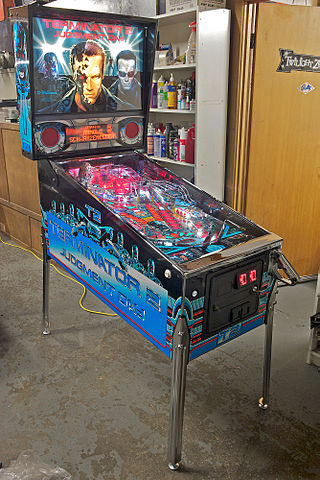
Pinball games are a family of games in which a ball is propelled into a specially designed table where it bounces off various obstacles, scoring points either en route or when it comes to rest. Historically the board was studded with nails called 'pins' and had hollows or pockets which scored points if the ball came to rest in them. Today, pinball is most commonly an arcade game in which the ball is fired into a specially designed cabinet known as a pinball machine, hitting various lights, bumpers, ramps, and other targets depending on its design.
A glossary of terms, commonly used in discussing pinball machines.

Pin-Bot is a pinball machine released by Williams in October 1986. It was designed by Python Anghelo and Barry Oursler.

The Addams Family is a pinball machine released in March 1992. It was designed by Pat Lawlor and Larry DeMar and released by Midway. It was based on the 1991 film of the same name, and features custom speech by the stars of the film, Anjelica Huston and Raul Julia. It is the best-selling solid state pinball machine of all time with 20,270 units sold.

Twilight Zone is a widebody pinball machine, designed by Pat Lawlor and based on the TV series of the same name. It was first released in 1993 by Midway. This game is part of WMS' SuperPin line of widebody games alongside Star Trek: The Next Generation and Indiana Jones: The Pinball Adventure.

Cirqus Voltaire is a 1997 pinball game, designed by John Popadiuk and released by Williams Electronics Games. The theme involves the player performing many different marvels in order to join the circus. Some of the game's distinctive features include a neon light running along the right-hand ramp, a pop bumper that rises up from the middle of the playfield at certain times, and a magnet at the top of the left ramp that can catch balls and divert them into the locks. The most notable feature is the Ringmaster, a head that rises at certain times and taunts the player.

Indiana Jones: The Pinball Adventure is a 1993 widebody pinball game designed by Mark Ritchie and released by Williams. It was based on the first three Indiana Jones movies. It was also part of WMS' SuperPin series of widebody games.

Black Rose is a pinball machine designed by John Trudeau and Brian Eddy and produced by Midway. The game features a pirate theme and was advertised with the slogan "This game is loaded!".Bally abandoned the idea to use black pinballs for the machine.

World Cup Soccer is a 1994 pinball machine designed by John Popadiuk and Larry DeMar and released by Midway. It is based on the 1994 FIFA World Cup, with gameplay mechanics largely centered around the sport. Though multiple digital versions of the game have been created, they are no longer accessible through normal means.

Creature from the Black Lagoon is a pinball machine designed by John Trudeau and released by Midway. It is loosely based on the movie of the same name. The game's theme is 1950s drive-in theater. The pinball game was licensed from Universal Studios by Bally so that all backglass and cabinet artwork and creature depictions would resemble those of the original movie.

Mary Shelley's Frankenstein is a 1995 pinball machine released by Sega Pinball. It is based in the film of the same name.
Police Force is a 1989 Williams pinball machine. The pinball machine was initially supposed to be released as Batman pinball, the police car was to be the Batmobile and the Jail was to be the Bat Cave. The machine features anthropomorphic jungle animals in the roles of police and robbers.

The Party Zone is a crossover solid-state pinball machine released in 1991 by Midway designed by Dennis Nordman and programmed by Jim Strompolis. It is in a single playfield format and collaborates characters from previous pinball machines. It is the second pinball machine released after the Bally-Midway division was sold, yet still operated under the "Bally" name.

Judge Dredd is a four-player pinball game produced by Bally Manufacturing in 1993, based on the British comic strip Judge Dredd in 2000 AD. Nearly 7,000 were made.

Comet is a pinball machine released by Williams in June 1985. It was designed by Barry Oursler, who was inspired by the Comet roller coaster at Riverview Park in Chicago, and was the first in an amusement park themed pinball trilogy followed by Cyclone in 1988 and Hurricane in 1991.

Genie is a widebody pinball machine designed by Ed Krynski and released in 1979 by Gottlieb. It features a jinn theme and was advertised with the slogans "Gottlieb's WIDE and Beautiful BODY" and "A Wide-Body Pinball absolutely bulging with player appeal and proven massive profit earning capacity!".

Flight 2000 is a 1980 Stern widebody pinball machine. It was the first table by this company with speech. The theme of the game revolves around futuristic space flight.

Cue Ball Wizard is a pinball machine designed by Jon Norris and released in December 18 1992 by Gottlieb. It features a cue sports theme and was advertised with the slogan "Gottlieb Presents CUE BALL WIZARD!".

Sorcerer is a 1985 pinball machine designed by Mark Ritchie and released by Williams Electronics. The table is placed in the "Internet Pinball Data Base Top 100 Rated Electronic Pinball Machines" chart.

Hurricane is a pinball machine released by Williams Electronics in August 1991. It was designed by Barry Oursler as the third game in Oursler's amusement park themed pinball trilogy. The first being Comet, released in 1985, and the second being Cyclone, released in 1988.


















